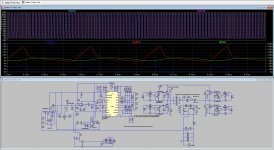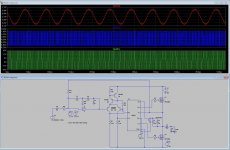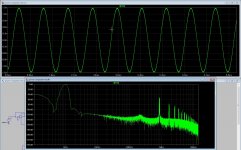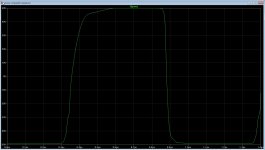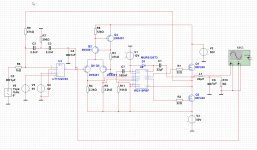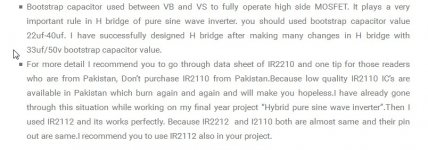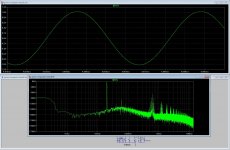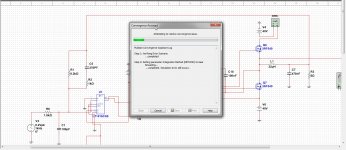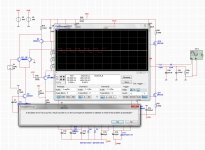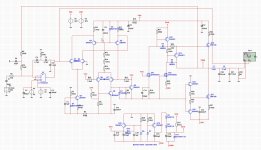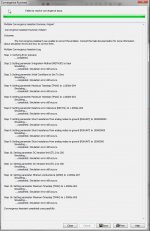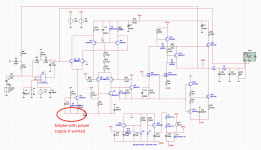No but there are papers about it who says when using a triangle carrier you need a fast comparator and opamp to make one, and to get as lineair asd possible, however the new self oscillation amps did push them to the background.
Dear keen52,
What is the relevance?
- Is there anything said about noise in that papers?
- Since when ultrafast and fast means the same?
- Who wrote anything about triangle generation this before in this topic?
- I explicitely wrote an exception: unless preamp is preceeding the comparator. OPA is an amp in front of comparator in a triangle generator, so this case is part of the exception.
Plus these requirements are stupid generalisations of a very particular case. I've built many high quality triangle generators without fast comparator. Or any comparator actually. There are much more possibilities then you could dream of. And excellent linearity of triangle wave is not required in reality. Very limited knowledge is the source of these fairy tales. And you seem to collect them all carefully. Basically your way of thinking is antagonist to mine.
On picture I get the comparator have fast fall times but slower risetimes, this is due to the bigger gate resistors to get less shoot through, I think that also for the pcb is to use gate driver ic,s who do make it much easy to design a clean pcb.
Sorry, I gave it up. After 5 times re-reading 50 % of your writing is still impossible for me to understand, 25% is found not true, 20% is maybe true but without visible relevance (mainly because of untold parameters), 4 % is true and relevant but not interesting, and 1 percent is true, relevant and interesting.
I see promising signs, like for example your first high resolution switching waveform screenshot, but there are sooo many other requirements to make your posts sources of easily understandable informations... And I get soo few feedback from you showing you got what I wrote. Refusal, ignorance or denial almost always. Questions? Hardly ever.
the ir2110 lm311 ltspice models .other d models too have fun simulating 😀 😀
Thanks man!!
Have a nice ay.
Dear keen52,
What is the relevance?
- Is there anything said about noise in that papers?
- Since when ultrafast and fast means the same?
- Who wrote anything about triangle generation this before in this topic?
- I explicitely wrote an exception: unless preamp is preceeding the comparator. OPA is an amp in front of comparator in a triangle generator, so this case is part of the exception.
Plus these requirements are stupid generalisations of a very particular case. I've built many high quality triangle generators without fast comparator. Or any comparator actually. There are much more possibilities then you could dream of. And excellent linearity of triangle wave is not required in reality. Very limited knowledge is the source of these fairy tales. And you seem to collect them all carefully. Basically your way of thinking is antagonist to mine.
Sorry, I gave it up. After 5 times re-reading 50 % of your writing is still impossible for me to understand, 25% is found not true, 20% is maybe true but without visible relevance (mainly because of untold parameters), 4 % is true and relevant but not interesting, and 1 percent is true, relevant and interesting.
I see promising signs, like for example your first high resolution switching waveform screenshot, but there are sooo many other requirements to make your posts sources of easily understandable informations... And I get soo few feedback from you showing you got what I wrote. Refusal, ignorance or denial almost always. Questions? Hardly ever.
Yes she do, it are university papers, I do read them because it is the best way to learn understand the topology, and I have experience with smps already, like the build 140 amp welder inverter with fase shift zvs/zcs.
http://scholar.sun.ac.za/bitstream/10019.1/20084/2/kemp_design_2012.pdf
http://www.infineon.com/dgdl/an-1071.pdf?fileId=5546d462533600a40153559538eb0ff1
this are some papers, and these people do measure also noise and stuff, the most important part also.
You have to understant Pafi, I get the info most from professional designers, and it is not a way to say it has to be, it is just a result of investications of how things are presented, as you say, in your old days you did make very nice triangle with standart components I do agree, but there is a paper who explane why the stuf needs to be fast, just for the last numbers behind the comma what concerns harminic distortion.
Here the use of fast stuff and explain why.
http://www.ti.com/lit/ug/slau508/slau508.pdf
I have a phillips tv who has a class d amp in it and phillips do sound well, always did for most audio products, that is why I go soon test things.
Need top buy some extra equipment.
Attachments
Last edited:
I did use the IR model from @analogspiceman, however I get uge shoot through, because in that model I do not see adjustment for death time.
Maybe someone here? has tips.
Last photo is from the discrete comparator with hd correction with a multipole lowpass opamp, it get in sim to -100dB, in real? I do not now but test someday.
regards
Maybe someone here? has tips.
Last photo is from the discrete comparator with hd correction with a multipole lowpass opamp, it get in sim to -100dB, in real? I do not now but test someday.
regards
Attachments
I don't suppose you've checked the datasheet for (for example) that IR2011, have you?
If you did, you would've noticed there's clearly no dead-time adjustment (and it's DEAD-time, by the way).
If you want dead-time, it needs to be created before these driver chips. A 74HC86 and a couple resistors, diodes and caps are enough.
PS: You really want some anti-parallel diodes across those gate resistors (to help turn the FETs off quicker). It will definitely help reduce cross-conduction / "shoot-through".
If you did, you would've noticed there's clearly no dead-time adjustment (and it's DEAD-time, by the way).
If you want dead-time, it needs to be created before these driver chips. A 74HC86 and a couple resistors, diodes and caps are enough.
PS: You really want some anti-parallel diodes across those gate resistors (to help turn the FETs off quicker). It will definitely help reduce cross-conduction / "shoot-through".
Last edited:
I don't suppose you've checked the datasheet for (for example) that IR2011, have you?
If you did, you would've noticed there's clearly no dead-time adjustment (and it's DEAD-time, by the way).
If you want dead-time, it needs to be created before these driver chips. A 74HC86 and a couple resistors, diodes and caps are enough.
PS: You really want some anti-parallel diodes across those gate resistors (to help turn the FETs off quicker). It will definitely help reduce cross-conduction / "shoot-through".
I have did sim with IR2010 I have peak in the datasheet and have not look better. I need a driver with dead-time. (hmm I learn english also).
Thanks for the tip.
here is a link to one.
http://omapalvelin.homedns.org/electr/pwm-deadtime-gen/
For as you people do now more about class D then me, I would like to hear why the dead-time of this comparator do act so bad, I have raise the gate resistors to 150 ohms, and current do drop, also when I put audio inpu on zero, the oscillation do stop, it starts again with audio input on 0.1 volts.
For as the chip, I do go search one who as onboard dead time setup, is so much more easy to make a pcb when things are in the chip.
On last picture it looks the comparator is quite fast even with 150 ohm gate resistors, better fall time then rise time.
regards
For as the chip, I do go search one who as onboard dead time setup, is so much more easy to make a pcb when things are in the chip.
On last picture it looks the comparator is quite fast even with 150 ohm gate resistors, better fall time then rise time.
regards
Attachments
Last edited:
This is a nice chip, single input and programmable dead time and protections.
10 PCS IRS20124S IRS20124 IRS20124STRPBF SOP14 SMD New | eBay
10 PCS IRS20124S IRS20124 IRS20124STRPBF SOP14 SMD New | eBay
Have try some sim in multisim who has a lot of driver ic,s models, but non do work as in LT spice, what is the reason of that? only the @analogman do work.
http://www.irf.com/product-info/audio/classdtutorial606.pdf
the schematic do work in ltspice with analog model, but not in multisim and also the others in ltspice do not work.
The discrete comparators do work fine in sim, why the chips do not better i do not understand..
regards
http://www.irf.com/product-info/audio/classdtutorial606.pdf
the schematic do work in ltspice with analog model, but not in multisim and also the others in ltspice do not work.
The discrete comparators do work fine in sim, why the chips do not better i do not understand..
regards
Attachments
I do not now it people are aware but I do put it here.
How to use MOSFET DRIVER 1R2110
Some part of important tekst in picture.
Has someone a example of a dead time generator for the IR2110? or better 2112, maybe someone has made already a amp and I can then use it for testing..
thanks.
regards
How to use MOSFET DRIVER 1R2110
Some part of important tekst in picture.
Has someone a example of a dead time generator for the IR2110? or better 2112, maybe someone has made already a amp and I can then use it for testing..
thanks.
regards
Attachments
Some material about coil design, is also very important.
http://www.ti.com/lit/an/slaa701a/slaa701a.pdf
http://www.ti.com/lit/an/slaa701a/slaa701a.pdf
Yes she do, it are university papers,
Try it in English! I don't speak your language.
Are you able to answer to a question asked from you?
Yes, for somebody who understands them.I do read them because it is the best way to learn
understand the topology, and I have experience with smps already, like the build 140 amp welder inverter with fase shift zvs/zcs.
Experience or knowledge. Not the same.
http://scholar.sun.ac.za/bitstream/10019.1/20084/2/kemp_design_2012.pdf
http://www.infineon.com/dgdl/an-1071.pdf?fileId=5546d462533600a40153559538eb0ff1
this are some papers, and these people do measure also noise and stuff, the most important part also.
They are good. Read them! Can you find anything contradictional to my statement about noise of ultrafast comparators? If yes, then quote it! I bet the authors make noise measurements somewhere, some time, but where can you see it in the papers you linked?!? Where can you find noise comparisons for different speed comparators? Or any other sign that shows ultrafast comparator superiority over simply fast ones?
Did you notice that the kemp design demonstrate the usefulness of a nonlinear (predistorted) carrier??? (In contrast with the TI design, what is optimised for only a plain modulator having almost no delay, no power section and obviously no post-filter feedback, and still did not reach a quite good performance.)
You have to understant Pafi, I get the info most from professional designers,
You may get info from professionals, but you distort it many ways so much that impossible to recognize the origin. You have to understand that knowing syntax and logic are neccessary for both learning and communication. Just like answering questions.
and it is not a way to say it has to be, it is just a result of investications of how things are presented,
This seems to be English, but I can't decode the meaning. Even less the relevance.
as you say, in your old days
No, I never said it was in my old days. It is persistent. I never use ultrafast comparator for triangle generation. I could, but there are better ways. Using fast comparator and fast OPA in the usual topology is the most trivial way, but not the only, and there are problems with it when used in more complex systems.
you did make very nice triangle with standart components I do agree,
You said not agree.
but there is a paper who explane why the stuf needs to be fast,
"The stuf"? Which stuff? The comparator of their chosen triangle generator? Or the modulator? And fast or ultrafast? I wrote ultrafast.
Please try to find the part where they wrote that ultrafast comparators does not have higher noise! And the part where they wrote that ultrafast comparators are better than fast ones in applications different from the specific one they presented.
What number and what comma? What are you talking about at all? Can you make a meaningful sentence?just for the last numbers behind the comma what concerns harminic distortion.
This is written there: "Keeping the comparator propagation delay less than 1/10th the period of the PWM waveform is a good
design goal."
Let's see: 2 us/10 = 200 ns. It is very-very far from ultrafast (like the 4.5 ns proposed here). And nothing is mentioned about noise.
But there is an important advice:
"Because this circuit’s operation depends on rapid changes in output voltages as well as an oscillator circuit, it is best to simulate the design in separate parts to confirm functionality and avoid convergence issues in SPICE simulators. For this reason, the error amplifier and comparator were simulated separately from the triangle wave generator."
This is always recommended, not only the triangle generator and modulator, but every section is very good to be simulated (and optimised) separately first, not only to decrease simulation time, but to be able to understand how these parts work.
Last edited:
A very bad one. Not just because it unneccessarily uses a logic gate where a diode is enough, and power supply of the gate is limited to 5V, which is quite impractical, but also because it can give a possibly damaging result if the input signal is not fast enough. It causes a so-called static hazard, which then turns into a dynamic hazard. Digital technology, 2nd month lession on university. (Or 5th month in technical school.)
it would be nice if you run a phase analysis of the class D amplifier and share here your results.
example : amplification in db / frequency in top graph, Phase vs frequency in bottom graph
example : amplification in db / frequency in top graph, Phase vs frequency in bottom graph
it would be nice if you run a phase analysis of the class D amplifier and share here your results.
example : amplification in db / frequency in top graph, Phase vs frequency in bottom graph
I wil do after night.
regards
No even discrete do not work, I get errors and if automaticly solved it do nothing, multisim is not good for digital simulation, is buggy also, orcad Pspice is much better, and ltspice also, Tina I have never tested.
Digital technology is and stays critical when simulate it.
The schematic is the same as I have in LTspice where it do work fine.
Digital technology is and stays critical when simulate it.
The schematic is the same as I have in LTspice where it do work fine.
Attachments
- Home
- Amplifiers
- Class D
- Class D investigation.
